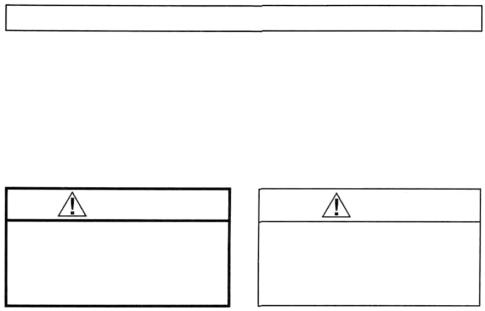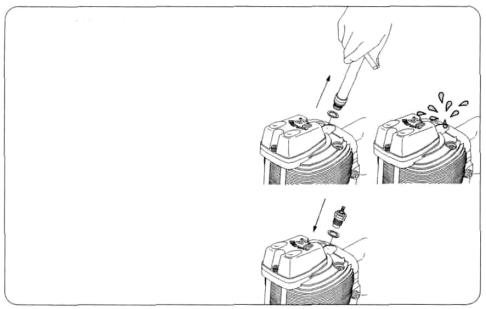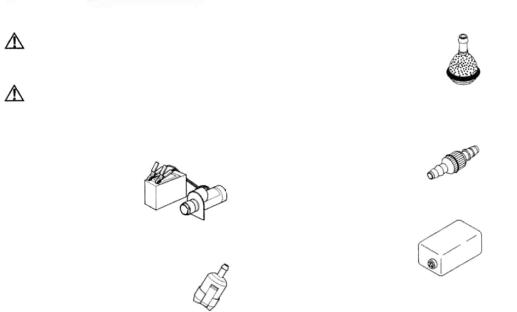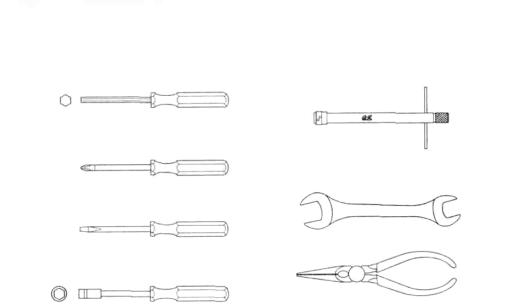OS FL70 User Manual

FL-70
FOUR CYCLE ENGINE
OWNER'S INSTRUCTION MANUAL
It is of vital importance, before attempting to operate your engine, to read the general
•SAFETY INSTRUCTIONS AND WARNINGS' section on pages 2-6 of this booklet and to strictly adhere to the advice contained therein.
•Also, please study the entire contents of this instruction manual, so as to familiarize yourself with the controls and other features of the engine.
•Keep these instructions in a safe place so that you may readily refer to them whenever necessary.
•It is suggested that any instructions supplied with the aircraft, radio control equipment, etc., are accessible for checking at the same time.

CONTENTS |
|
SAFETY INSTRUCTIONS AND WARNINGS |
|
ABOUT YOUR O.S. ENGINE ---------------- |
2-6 |
ENGINE CONSTRUCTION ------------------------ |
7 |
NOTES WHEN APPLYING AN ELECTTRIC STARTER |
---- 8 |
INTRODUCTION -------------------------- |
9 |
BEFORE STARTING ---------------------- |
10-13 |
ENGINE PARTS NAME-------------------------------------- |
14 |
INSTALLATION ------------------------------------------------ |
15-16 |
SILENCER & EXHAUST HEADER PIPE INSTALLATION ------- |
17 |
FUEL TANK & LINES -------------------------------- |
18-20 |
THROTTLE LINKAGE, NEEDLE-VALVE EXTENSION ------ |
21 |
PROPELLER & SPINNER ATTACHMENT ---- |
22-23 |
GLOWPLUG ------------------------------------------- |
24 |
TYPE 60W CARBURETOR, STARTING -------- |
25-27 |
RUNNING -IN, CARBURETOR -------------------- |
27-30 |
CARBURETOR AIR-BLEED ADJUSTMENT - - - - - - |
- - 31 |
TROUBLE SHOOTING WHEN THE |
|
ENGINE FAILS TO START----------------------- |
32-33 |
VALVE ADJUSTING - - - - - - - - - - - - - - - - - - - - - - - - - - - - - |
- - - 34 |
HOW TO SET THE CAMSHAFT TIMING --------- |
35 |
CARE AND MAINTENANCE ----------------------- |
36-37 |
ENGINE EXPLODEDVIEWS & PARTS LIST -------- |
38-39 |
CARBURETOR EXPLODED VIEWS |
|
& PARTS LIST ---------------------------------------- |
40-41 |
GENUINE PARTS & ACCESSORIES ------- |
42-43 |
THREE VIEW DRAWING --------------------------------- |
44 |
1

SAFETY INSTRUCTIONS AND WARNINGS ABOUTYOUR O.S. ENGINE
Remember that your engine is not a "toy", but a highly efficient internalcombustion machine whose power is capable of harming you, or others, if it is misused.
As owner, you, alone, are responsible for the safe operation of your engine, so act with discretion and care at all times.
If at some future date, your O.S. engine is acquired by another person, we would respectfully request that these instructions are also passed on to its new owner.
The advice which follows is grouped under two headings according to the degree of damage or danger which might arise through misuse or neglect.
WARNINGS |
NOTES |
These cover events which might involve serious (in extreme circumstances, even fatal) injury.
These cover the many other possibilities, generally less obvious sources of danger, but which, under certain circumstances, may also cause damage or injury.
2

WARNINGS
Never touch, or allow any object to come into contact with, the rotating
propeller and do not crouch over the engine when it is running.
A weakened or loose propeller may disintegrate or be thrown off and, since propeller tip speeds with powerful engines may exceed 600 feet(180 metres) per second, it will be understood that such a failure could result in serious injury, (see 'NOTES' section relating to propeller safety).
Model engine fuel is poisonous. Do not allow it to come into contact with the eyes or mouth. Always store it in a
clearlymarkedcontainerand out of the reach of children.
Model engine fuel is also highly flammable. Keep it away from open flame, excessive heat, sources of sparks, or anything else which might
ignite it. Do not smoke or allow anyoneelsetosmoke,nearto it.
Never operate your engine in an enclosed space. Model engines, like automobile engines, exhaust deadly carbonmonoxide. Run your engine only in an open area.
Model engines generate considerable heat. Do not touch any part of your engine until it has cooled. Contact with the muffler (silencer),
cylinder head or exhaust header pipe, in particular, may result in a serious burn.
3

NOTES
This engine was designed for model aircraft. Do not attempt to use it for any other purpose.
Mount the engine in your model securely, following the manufacturers' recommendations, using appropriate screws and locknuts.
Be sure to use the silencer (muffler) supplied with the engine. Frequent exposure to an open exhaust may eventually impair your hearing.
Such noise is also likely to cause annoyance to others over a wide area.
If you remove the glowplug from the engine and check its condition by connecting the battery leads to it, do not hold the plug with bare fingers.Use an appropriate tool or a folded piece of cloth.
Install a top-quality propeller of the diameter and pitch specified for the engine and aircraft. Locate the propeller on the shaft so that the curved face of the blades faces forward-i.e. in the direction of flight. Firmly tighten the propeller nut, using the correct size wrench.
4

NOTES
Always check the tightness of the propeller nut and retighten it, if necessary, before restarting the engine, particularly in the case of four-stroke-cycle engines. If a safety locknut assembly is provided with your engine, always use it. This will prevent the propeller from flying off in the event of a
"backfire", even if it loosens. Also, check the tightness of all the screws and nuts before restarting the engine.
If you install a spinner, make sure that it is a precision made product and that the slots for the propeller blades do not cut into the blade roots and weaken them.
Preferably, use an electric starter. The wearing of safety glasses is also strongly recommended.
Discard any propeller which has become split, cracked, nicked or otherwise rendered unsafe. Never attempt to repair such a propeller: destroy it. Do not modify a propeller in any way, unless you are highly experienced in tuning propellers for specialized competition work such as pylon-racing.
Take care that the glow plug clip or battery leads do not come into contact with the propeller. Also check the linkage to the throttle arm. A disconnected linkage could also foul the propeller.
After starting the engine, carry out any needle-valve readjustments from a safe position behind the rotating propeller. Stop the engine before attempting to make other adjustments to the carburetor.
5

NOTES
Adjust the throttle linkage so that the engine stops when the throttle stick and trim lever on the transmitter are fully retarded. Alternatively, the engine may be stopped by cutting off the fuel supply. Never try to stop the engine physically.
Take care that loose clothing (ties, shirt sleeves, scarves, etc.)do not come into contact with the propeller. Do not carry loose objects (such as pencils, screwdrivers, etc.) in a shirt pocket from where they could fall through the propeller arc.
Do not start your engine in an area containing loose gravel or sand.
The propeller may throw such material in your face and eyes and cause injury.
For their safety, keep all onlookers
(especially small children) well back (at least 20 feet or 6 meters) when preparing your model for flight. If you have to carry the model to the take-off point with the engine running, be especially cautious. Keep the propeller pointed away from you and walk well clear of spectators.
Warning! Immediately after a glowplugignition engine has been run and is still warm, conditions sometimes exist whereby it is just possible for the engine to abruptly restart if the propeller is casually flipped over compression WITHOUT the glowplug battery being reconnected. Remember this if you wish to avoid the risk of a painfully rapped knuckle!
6

ENGINE CONSTRUCTION
With this engine, the piston will feel tight at the top of its stroke (TDC) when the engine is cold.
This is normal.
The cylinder bore Is a little tapered.
The piston and cylinder are designed to achieve a perfect running clearance when they reach their running temperatures.
Piston
Cylinder Liner
Crankshaft
A little tapered
When the engine is cold. When the engine is hot

NOTES WHEN APPLYING AN ELECTRIC STARTER
Do not over-prime. This could cause hydraulic lock and damage the engine on application of the electric starter.
If over-primed, remove glowplug, close needle-valve and apply starter to pump out surplus fuel. Cover the head with waste to prevent pumped out fuel coming into your eyes.
8

INTRODUCTION
The FL-70 is an air-cooled, overheadvalve four stroke engine for model aircraft use. This engine is suitable for trainer, sport and scale models.
This engine reduces maintenance by incorporating the first O.S. ringless piston/liner assembly. Also, a sealed front bearing prevents oil leaks. The engine is fitted with the new easy-to use O.S. 60W airbleed carburetor. This engine is designed so that more R/0 pilots, from hobby beginners to skilled Sunday fliers may enjoy the performance advantages of four stroke engines - greater fuel economy, higher torque, lower noise and realistic sund.
STANDARD ACCESSOIES
Glow Plug Type F
(fitted with the engine)
F-4030 Silencer Assembly
T Nipple
9

BEFORE STARTING
Tools, accessories, etc.The following items are necessary for operating the engine.
 Items necessary for starting
Items necessary for starting
GLOW PLUG
O.S. Type F glowplug is installed in the engine.
GLOWPLUG IGNITER
Commercialy available handy glowplug heater in which the glowplug battery and battery leads are integrated.
FUEL PUMP
Alternatively, one of the purpose-made manual or electric fuel pumps may be used to transfer fuel directly from your fuel container to the fuel tank.
FUEL
The FL-70 should be operated on a methanol based fuel containing not less than 20% (volumetric) castor oil, or a top quality synthetic lubricant (or a mixture of both), plus a small percentage (5-15%) of nitromethane for improved flexibility and power. (The carburetor is adjusted at the factory for a fuel containing 20% lubricant and 15% nitromethane.) Some commercial fuels also contain coloring additives as an aid to fuel level visibility. In some cases, these additives have indicated slightly negative effects o performance.
We would suggest that you use such fuels only if you are satisfied that they do not adversely affect running qualities when compared with familiar standard fuels. When changing to a fuel brand or formula that is different from the one
to which you are accustomed, it is a wise precaution to temporarily revert to in-flight running-in procedures, until you are sure that the engine is running entirely satisfactorily.
10

Reminder!
Model engine fuel is poisonous. Do not allow it to come into contact with the eyes or mouth. Always store it in a clearly marked container and out of the reach of children.
Model engine fuel is also highly flammable. Keep it away from open flame, excessive heat, sources of sparks, or anything else which might ignite it. Do not smoke, or allow anyone else to smoke, near to it.
Electric Starter and
StarterBattery
Required when starting
the engine. |
12Volt lead-acid battery |
|
|
|
Electric Starter |
O.S. Super Filter (Fuel Can Filter)
Fit a filter to the outlet tube of your refueling container to prevent entry of foreign matter into fuel tank. O.S. 'Super Filters' (large and small) are available as optional extras.
O.S. Non-Bubble Weight
To prevent the pickup from adhering to the tank wall under suction and restricting fuel flow, slots may be filed I the end of the weight. Alternatively, O.S. Non-Bubble Weight is available as an optional extra.
Fuel Filter
It is recommended to fit a good in-line filter between the fuel tank and carburetor to prevent entry of foreign matter into the carburetor.
Fuel Tank
A fuel tank of approximately 300cc capacity is suggested. This allows around 10 minutes flying time, dependent upon the
type of fuel used, the size of propeller and on the proportion of full-throttle to part-throttle operation throughout the flight.
11

Spinner
Since the FL-70 is intended to be started with an electric starter, the addition of a spinner assembly for
centering the starter sleeve is desirable. Use a heavy-duty, well balanced spinner either of metal or plastic.
SILICONE FUEL LINE
Heatproof silicone tubing of approx. 5mm o.d. and 2.5mm i.d. is required for the connection between the fuel tank and engine.
Propellers
The choice of propeller depends on the design and weight of the aircraft and o the type of flying in which you will be engaged. Determine the best size and type after practical experimentation. As a starting point, refer to the props listed in the accompanying table. Slightly larger, or even slightly smaller, props
than those shown in the table may be used, but remember that the propeller noise will increase if blade tip is raised, due to higher rpm or if a larger-diameter/lower-pitched prop is used.
Sport & Aerobatic |
12X7, 12.5X6, 13X6 |
Trainer & Scale |
12.5X6, 13X6-7 |
|
|
Warning:
Make sure that the propeller is well balanced. An unbalanced propeller and/or spinner can cause serious vibration which may weaken parts of the airframe or affect the safety of the radio-controlled system.
DO NOT forget the WARNINGS and NOTES on propeller and spinner safety given on front pages.
Reminder!
Never touch, or allow any object to come Into contact with, the rotating propeller and do not crouch over the engine when it Is running.
12

• TOOLS
HEX WRENCH
Necessary for engine installation. 1.5mm, 2mm, 2.5mm, 3mm opposite side
Plus Threaded Drivers
No.1,No.2,etc.
SCREWDRIVER
Necessary for carburetor adjustments. No.1,No.2,etc
Box Wrenches
5.5mm, 7mm, 8mm opposite side
LONG SOCKET WRENCH WITH PLUG GRIP
Recommended for easy removal and replacement of the angled and recessed glowplug, the O.S.Long Socket Wrench incorporates a special grip.
8mm
Spanners
8mm, 13mm, 14mm, etc.
Nipper
13
